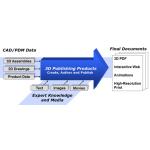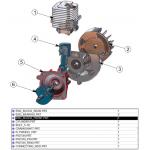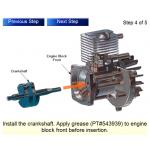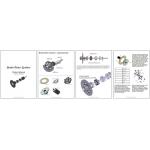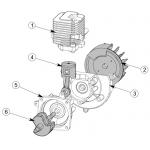Latest News
March 1, 2006
By Brian Roberts
Most product development companies have invested a great deal of time and digital data in their 3D CAD models and designs. Until relatively recently, all this information was locked up in CAD programs, unavailable to other partners in the product development chain. Now, however, software applications like QuadriSpace Document3D mean CAD models and their associated metadata can be leveraged for downstream product lifecycle management (PLM) processes. One of the most effective applications is the ability to publish either interactive 3D documents or high-resolution printed materials. These applications typically provide model editing, page layout, 3D publishing, and reader capabilities within a single suite of integrated products.
This process has helped cut the time to market, reduce documentation costs, improve designer and technical publication productivity, and produce more compelling and accurate documentation. The direct import of the CAD data assures first-pass accuracy, ending the need to generate intermediate bitmaps or other files. The integrated 3D documentation application eliminates the use of multiple programs (e.g., image processing, page layout, and publishing programs) and the translations between them. Streamlining the process reduces documentation time and effort by an estimated 20 to 40 percent. Furthermore, with existing processes, companies have reported that one quarter to half of the designer’s time is spent supporting downstream documentation requirements. This time expenditure, however, is virtually eliminated by new processes (see Figure 1, below) because 3D documentation and document/illustration generation takes place outside the CAD environment. Instead, the publication specialist can create the required views and render styles independently and more efficiently. Finally, documents that contain interactive 3D views, 2D drawings, images, movies, and text convey information more effectively than static documents.
|
|
| Figure 1: 3D documentation applications make it possible to publish interactive 3D or printed material directly from design information. |
This documentation approach can improve multiple phases of the PLM process: It enables customer feedback and collaborative design review to help improve product design. It lends itself to assembly instructions and procurement packages to help improve production. And it helps create repair, maintenance, and operators manuals, training documents, and sales and marketing materials, thereby improving customer support.
Interactive Assembly Instructions
Some 3D documentation applications can create assembly instructions completely independent of a CAD program. These applications import the 3D CAD model and its associated metadata, then create the bill of materials (BOM) and assembly steps, change render styles, add markups, attach associated procedures, and capture critical views with special instructions. The screenshot in Figure 2 (below) shows a typical BOM with the part table automatically associated with the assembly so that selecting a part highlights it in the table or selecting the part name highlights it in the assembly.
|
|
| Figure 2: This view shows an interactive BOM (bill of materials). |
Figure 3 (below) shows an example screenshot of assembly steps. An assembly step takes place once a part is selected and moved. Each step can be easily animated with complex motions to show the actual assembly path. Editing capabilities allow the step sequence to be changed or grouped at will, and all related information remains associated with the appropriate step or part. Extensive information from the CAD tool or added by the document author can be associated with a given part, step, or assembly and is accessible via mouse-over tips. In an interactive document, the viewer allows the assembly step to be repeated from various viewpoints selected by the user.
Using the free readers, the assembler can progress step by step through the assembly sequence at will. Viewing the assembly step in 3D, from any perspective, greatly improves the understanding of the assembler, increases efficiency, and reduces errors. Hyperlinks provide direct access to common instructions and procedures that are resident on a central database.
|
|
| Figure 3: Interactive step-by-step instructions. |
Published document files are typically three to 10 percent of the size of the original CAD file and can be readily distributed throughout the plant or to manufacturing partners.
Printed Manuals
Creating manuals generally requires page layout and design capabilities not available in CAD tools or simple viewers. Modern printed manuals include many illustrations and diagrams that would benefit from using imported CAD information. Products, such as Document3D, provide full text editing, 3D model editing, illustration layout, markup, custom render styles, and other tools necessary for working with document pages and 3D concurrently. Figure 4 shows an example printed document with multiple pages. Entire manuals and technical documents are created in this way using a single software application instead of a variety of point solutions. In addition, updates to documentation are simply a matter of reimporting updated CAD designs, which are automatically incorporated into the entire document.
A few 3D documentation applications support either interactive 3D manuals or printed manuals. For interactive manuals, the models remain fully interactive for rotating, zooming, panning, or animating. The animations are easily created using the step generation capability or by importing explode steps created in the 3D CAD application. 2D drawings and images can be used in the documents and can also be interactive.
|
|
| Figure 4: This is an example of a printed manual that was created using Document3D from QuadriSpace. |
Selected applications can also embed “navigation” capabilities in the document. These can be hot links or buttons that take the reader to predefined information, animate a 3D view, or hyperlink to a location in the document. This provides quick access to specific sections without searching through the entire document and presents immediate linkage to complementary information.
For printed manuals, some applications have a printed copy output that uses the initial setup views. These will print a copy of the interactive document without any required authoring, editing, or changes.
For those who want to continue using their current printed document authoring application, the 3D documentation application can be ideal for manipulating the CAD model to generate the static illustration. In this case, the author uses the model editing capability to create the illustrations by selecting the desired render style, setting up the view, hiding or showing selected parts, and creating annotations and call outs. This permits the author to define and generate the exact illustration without returning to the CAD designer to create the new view. Figure 5 (below) is one example of such an illustration. Once the illustrations are defined, they can be captured as a series of snapshots and output as high-resolution images for insertion into the printed document.
|
|
| Figure 5: 3D documentation applications are ideal for manipulating CAD models to generate static illustrations for those who want to use their current document authoring application. |
Generating both interactive and printed documents from the same master eases the transition between established legacy printed documents and modern electronic, interactive documents and provides critical time savings where it’s needed.
Electronic Documentation
In addition to the improved understanding and simplified generation of interactive documents, electronic documentation offers significant other business advantages. It is easy to control, store, and archive. It makes revisions simple and doesn’t require recreation of the entire document when designs change. It makes it a snap to distribute to remote locations, and doesn’t require CAD or special applications, so everyone in the enterprise can use it. And finally, it avoids printing costs, handling, and storage of paper documents.
When considered as part of the increasingly important PLM process, 3D documentation just makes sense. It unlocks data that already exists, giving more production line partners access to data that can help manufacturers on multiple levels.
Brian Roberts is president of QuadriSpace, he has a Bachelor of Science degree from the University of Texas and has worked in 3D visualization and publication products for 12 years. To reach him about this article, send an e-mail by clicking here. Please reference “Digital Data, March 2006” in your message.
Publish Interactive Docs to 3D PDF
Adobe’s recent release of its free Reader 7.0 includes interactive 3D capabilities that make it possible for non-CAD users to open and interact with 3D documents. While Acrobat 3D is Adobe’s new authoring tool for such documents, Document3D from QuadriSpace is focused on creating 3D PDF documents specifically for PLM.
Document3D includes page design features. In addition, this stand-alone product includes drag-and-drop tools for adding animated steps and interactive bills of materials without JavaScript programming. The software also offers update capabilities that make it easy to update large documents as your 3D CAD designs change.
Document3D is a complete solution for PLM publishing; users can author fully interactive documents without programming and publish these directly to Adobe’s 3D PDF format.
Download an example 3D PDF or a fully functional trial version from the QuadriSpace website by clicking here.—BR
Product Information
Document3D
QuadriSpace
Allen, TX
Subscribe to our FREE magazine, FREE email newsletters or both!
Latest News
About the Author
DE’s editors contribute news and new product announcements to Digital Engineering.
Press releases may be sent to them via [email protected].







